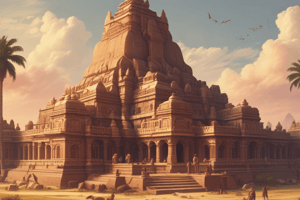Podcast
Questions and Answers
What role do archaeological sources play in understanding ancient Indian history?
What role do archaeological sources play in understanding ancient Indian history?
- They provide fictional narratives.
- They only highlight literary traditions.
- They focus solely on modern historical events.
- They offer physical evidence of past civilizations. (correct)
Which of the following archaeological elements is NOT mentioned as a source for understanding ancient India?
Which of the following archaeological elements is NOT mentioned as a source for understanding ancient India?
- Artefacts
- Inscriptions
- Cave paintings (correct)
- Monuments and architecture
What type of insights do inscriptions provide regarding ancient Indian societies?
What type of insights do inscriptions provide regarding ancient Indian societies?
- Details on contemporary global politics.
- Information on rulers and administration systems. (correct)
- Analysis of modern technologies.
- Personal diaries of ancient citizens.
What is epigraphy the study of?
What is epigraphy the study of?
What does the study of pottery styles and tools reveal about ancient cultures?
What does the study of pottery styles and tools reveal about ancient cultures?
What is one major challenge faced when interpreting archaeological findings?
What is one major challenge faced when interpreting archaeological findings?
Which of the following aspects of ancient Indian society is supported by archaeological evidence?
Which of the following aspects of ancient Indian society is supported by archaeological evidence?
How do archaeological sources enhance understanding of ancient Indian history?
How do archaeological sources enhance understanding of ancient Indian history?
What role do archaeological sites and artifacts play in cultural heritage?
What role do archaeological sites and artifacts play in cultural heritage?
What is the significance of cultural interactions evidenced by pottery analysis?
What is the significance of cultural interactions evidenced by pottery analysis?
What aspect of ancient Indian culture is depicted through artifacts like sculptures and paintings?
What aspect of ancient Indian culture is depicted through artifacts like sculptures and paintings?
What is the primary significance of numismatics in studying ancient societies?
What is the primary significance of numismatics in studying ancient societies?
Which of the following statements best describes the findings from archaeological excavations at sites like Harappa and Mohenjo-Daro?
Which of the following statements best describes the findings from archaeological excavations at sites like Harappa and Mohenjo-Daro?
What role does iconography play in the study of ancient Indian culture?
What role does iconography play in the study of ancient Indian culture?
The evolution of architectural styles in ancient India is best understood by studying which aspect of its history?
The evolution of architectural styles in ancient India is best understood by studying which aspect of its history?
Flashcards are hidden until you start studying
Study Notes
Importance of Archaeological Sources in Ancient Indian History
- Archaeology provides physical evidence that aids in understanding the cultural, social, and political landscapes of ancient India.
- Monuments and Architecture: Architectural structures like temples and stupas illustrate advancements in technology and aesthetic preferences of past societies.
- Inscriptions: Engraved on stone and metal, inscriptions reveal details about rulers, achievements, administrative systems, and religious practices.
- Artefacts: Physical remnants such as tools and pottery help illuminate the beliefs and daily lives of ancient Indian peoples.
Significance of Epigraphy
- Epigraphy, the study of inscriptions, has facilitated the deciphering of ancient scripts like Brahmi and Kharosthi, contributing greatly to understanding ancient languages.
Artistic Representation
- Art and Iconography: Sculptures, paintings, and carvings depict religious narratives and daily life, providing visual insights into ancient culture.
- The study of symbols helps interpret the significance of various deities in ancient Indian civilization.
Role of Numismatics
- The study of coins is essential for dating historical events and offers insights into the economic conditions and trade relations of ancient societies.
- Coin analysis reveals valuable information regarding political economies and cultural exchanges.
Archaeological Excavations
- Excavations at sites like Harappa and Mohenjo-Daro have uncovered evidence of the Indus Valley Civilization, showcasing advanced urban planning and infrastructure.
- Discoveries include sophisticated drainage systems, indicating a highly organized society.
Pottery and Tools
- Analysis of pottery styles and tools used by ancient people provides insights into their daily lives, technology, mobility, and cultural interactions among regions.
Challenges in Archaeological Sources
- Archaeological records are often incomplete or fragmented, complicating the reconstruction of a comprehensive historical narrative.
- Interpretations of findings can be subjective, leading to varied historical interpretations.
Complementary Role with Literary Sources
- Archaeological findings enhance literary sources, offering a more comprehensive view of ancient Indian history by confirming or questioning narratives in ancient texts.
Preservation of Cultural Heritage
- Archaeological sites and artifacts are crucial in preserving India’s rich cultural heritage and help foster national identity linked to its ancient past.
Studying That Suits You
Use AI to generate personalized quizzes and flashcards to suit your learning preferences.




